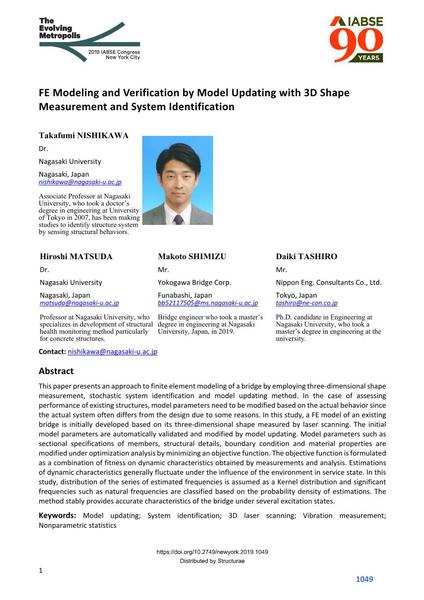FE Modeling and Verification by Model Updating with 3D Shape Measurement and System Identification

|
|
|||||||||||
Détails bibliographiques
| Auteur(s): |
Takafumi Nishikawa
(Nagasaki University)
Hiroshi Matsuda (Nagasaki University) Makoto Shimizu (Yokogawa Bridge Corp.) Daiki Tashiro (Nippon Eng. Consultants Co., Ltd.) |
||||
|---|---|---|---|---|---|
| Médium: | papier de conférence | ||||
| Langue(s): | anglais | ||||
| Conférence: | IABSE Congress: The Evolving Metropolis, New York, NY, USA, 4-6 September 2019 | ||||
| Publié dans: | The Evolving Metropolis | ||||
|
|||||
| Page(s): | 1049-1056 | ||||
| Nombre total de pages (du PDF): | 8 | ||||
| DOI: | 10.2749/newyork.2019.1049 | ||||
| Abstrait: |
This paper presents an approach to finite element modeling of a bridge by employing three‐dimensional shape measurement, stochastic system identification and model updating method. In the case of assessing performance of existing structures, model parameters need to be modified based on the actual behavior since the actual system often differs from the design due to some reasons. In this study, a FE model of an existing bridge is initially developed based on its three‐dimensional shape measured by laser scanning. The initial model parameters are automatically validated and modified by model updating. Model parameters such as sectional specifications of members, structural details, boundary condition and material properties are modified under optimization analysis by minimizing an objective function. The objective function is formulated as a combination of fitness on dynamic characteristics obtained by measurements and analysis. Estimations of dynamic characteristics generally fluctuate under the influence of the environment in service state. In this study, distribution of the series of estimated frequencies is assumed as a Kernel distribution and significant frequencies such as natural frequencies are classified based on the probability density of estimations. The method stably provides accurate characteristics of the bridge under several excitation states. |
||||
